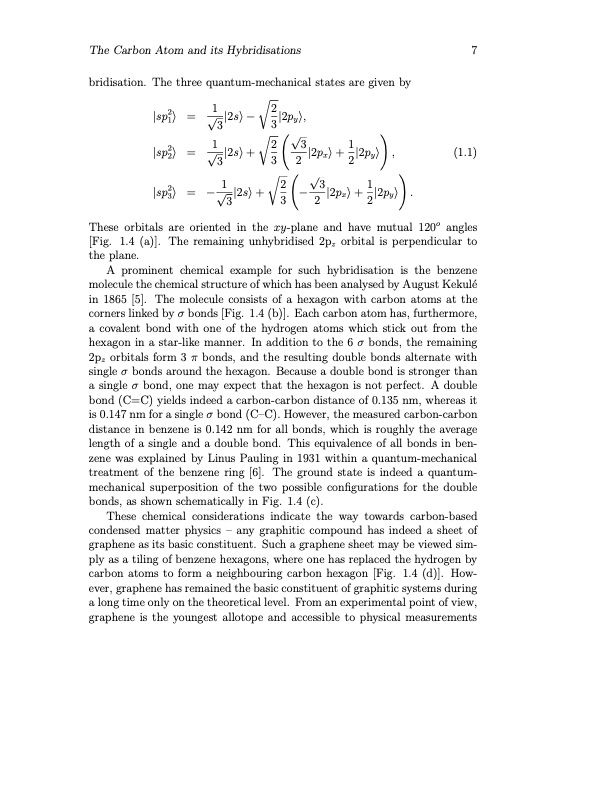PDF Publication Title:
Text from PDF Page: 011
The Carbon Atom and its Hybridisations 7 bridisation. The three quantum-mechanical states are given by 2 1 r2 |sp1⟩ = √3|2s⟩ − 3|2py⟩, 2 1r2√31! |sp2⟩ = √3|2s⟩+ 3 2 |2px⟩+2|2py⟩ , 2 1r2√31! |sp3⟩ = −√3|2s⟩ + 3 − 2 |2px⟩ + 2|2py⟩ . (1.1) These orbitals are oriented in the xy-plane and have mutual 120o angles [Fig. 1.4 (a)]. The remaining unhybridised 2pz orbital is perpendicular to the plane. A prominent chemical example for such hybridisation is the benzene molecule the chemical structure of which has been analysed by August Kekul ́e in 1865 [5]. The molecule consists of a hexagon with carbon atoms at the corners linked by σ bonds [Fig. 1.4 (b)]. Each carbon atom has, furthermore, a covalent bond with one of the hydrogen atoms which stick out from the hexagon in a star-like manner. In addition to the 6 σ bonds, the remaining 2pz orbitals form 3 π bonds, and the resulting double bonds alternate with single σ bonds around the hexagon. Because a double bond is stronger than a single σ bond, one may expect that the hexagon is not perfect. A double bond (C=C) yields indeed a carbon-carbon distance of 0.135 nm, whereas it is 0.147 nm for a single σ bond (C–C). However, the measured carbon-carbon distance in benzene is 0.142 nm for all bonds, which is roughly the average length of a single and a double bond. This equivalence of all bonds in ben- zene was explained by Linus Pauling in 1931 within a quantum-mechanical treatment of the benzene ring [6]. The ground state is indeed a quantum- mechanical superposition of the two possible configurations for the double bonds, as shown schematically in Fig. 1.4 (c). These chemical considerations indicate the way towards carbon-based condensed matter physics – any graphitic compound has indeed a sheet of graphene as its basic constituent. Such a graphene sheet may be viewed sim- ply as a tiling of benzene hexagons, where one has replaced the hydrogen by carbon atoms to form a neighbouring carbon hexagon [Fig. 1.4 (d)]. How- ever, graphene has remained the basic constituent of graphitic systems during a long time only on the theoretical level. From an experimental point of view, graphene is the youngest allotope and accessible to physical measurementsPDF Image | Physical Properties of Graphene

PDF Search Title:
Physical Properties of GrapheneOriginal File Name Searched:
CoursGraphene2008.pdfDIY PDF Search: Google It | Yahoo | Bing
Salgenx Redox Flow Battery Technology: Power up your energy storage game with Salgenx Salt Water Battery. With its advanced technology, the flow battery provides reliable, scalable, and sustainable energy storage for utility-scale projects. Upgrade to a Salgenx flow battery today and take control of your energy future.
CONTACT TEL: 608-238-6001 Email: greg@infinityturbine.com (Standard Web Page)